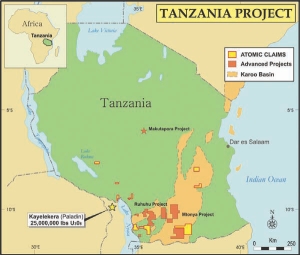Atomic Minerals (ATL-V, AMCMF-O) has begun a geological mapping and sampling program on its three uranium licences in the Mbinga district of Tanzania and has further plans in the works.
The company has budgeted US$467,000 on a program that will include airborne and radiometric surveying, trenching, pitting, assaying and shallow reverse- circulation drilling over 1,760 sq. km of land.
In a statement, Atomic president Warren McIntyre said the company is trying to advance its projects quickly.
Atomic began the mapping and sampling two months ago and has already collected 200 soil samples.
The exploration teams are currently doing uranium anomaly identification work on one of the licences, known as PL4335. The company is using both a gamma surveyor and gamma ray spectrometers. More than 1,000 readings have been taken over 40 sq. km of land.
A helicopter airborne magnetic and radiometric survey is also on the to-do list.
“Ground crews have already identified anomalies that require further investigation and once the company has the results of the airborne magnetic and radiometric information, we will be able to quickly and effectively identify drill targets for these properties,” McIntyre said.
Atomic can earn up to 100% in its total 3,800-sq.-km land package in Tanzania through an option agreement with the Tanzanian company, Geo Can Resources.
The larger properties, situated in southwestern Tanzania, are thought to be part of the “Malawi Extension” — located along the Tanzania- Malawi border. On the Malawi side is the Kayelekera deposit, which is being developed by Paladin Energy (PDN-T, PDN-A).
A technical report on the three properites was completed in December. It noted that the geologic conditions for Atomic’s three licences resemble those at Kayelekera, one of the largest Karoo sandstone- hosted deposits discovered so far. It is located about 150 to 200 km northwest on the west side of Lake Nyasa in Malawi.
The regional geology includes crystalline basement rocks (such as charnockite, granulite and gneisses, as well as minor granites and granodiorites) and Karoo sedimentary formations (sandstone and siltstone), which overlie the basement rocks.
The technical report notes similarities between Kayelekera and Mantra Resources’ (MRU-A) Mbamba Bay properties, located south of Atomic’s current licences, thereby validating the secondary uranium exploration models for the Mbinga area.
Secondary uranium minerals that are associated with siltstone clasts and lenses within medium-to coarse-grained sandstone assayed between 90 parts per million (ppm) and 0.68% U3O8 (6,800 ppm), while sandstone assays ranged between 65 ppm and 100 ppm.
The report says that sandstone deposits make up about 18% of the world’s uranium resources and that orebodies are usually low-to-medium grade (0.05% to 0.4% U3O8) and reach up to 50,000 tonnes U3O8 in size.
Atomic signed the final letter of intent for the Tanzania properties at the end of January. The company will pay Geo Can a total of $3.425 million and 3.425 million shares over four years.


Be the first to comment on "Atomic Minerals explores Tanzania"